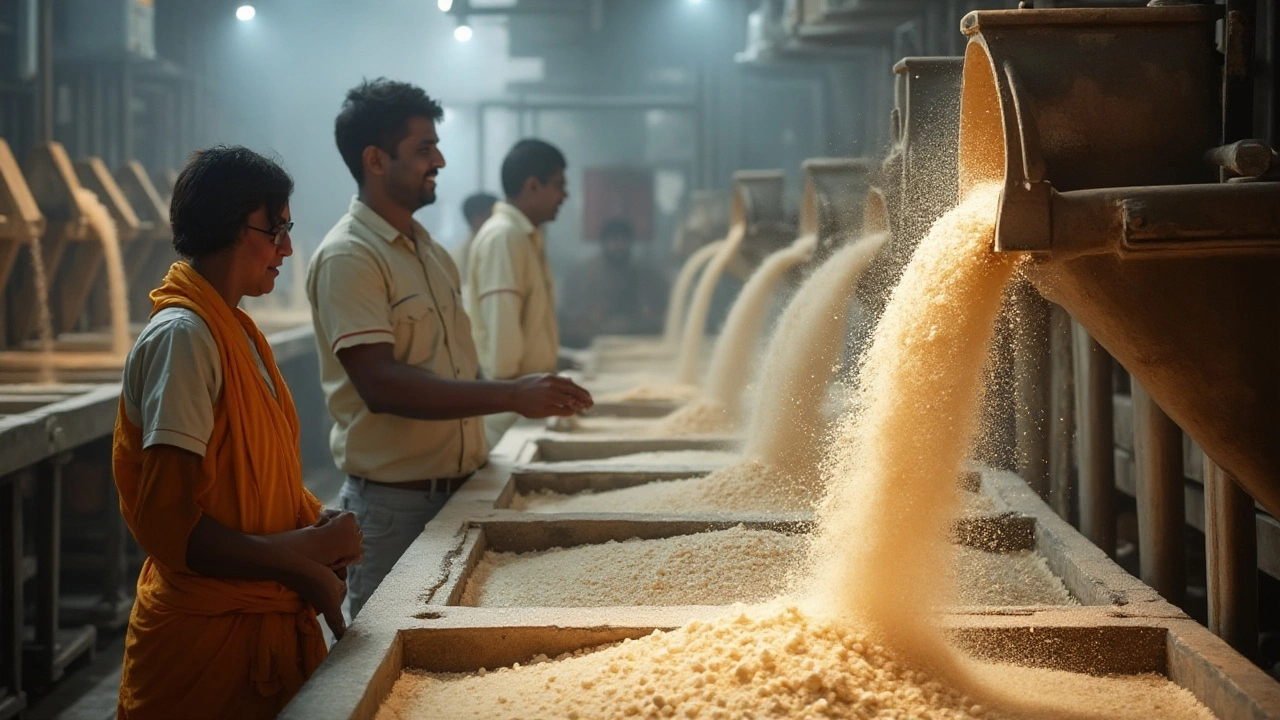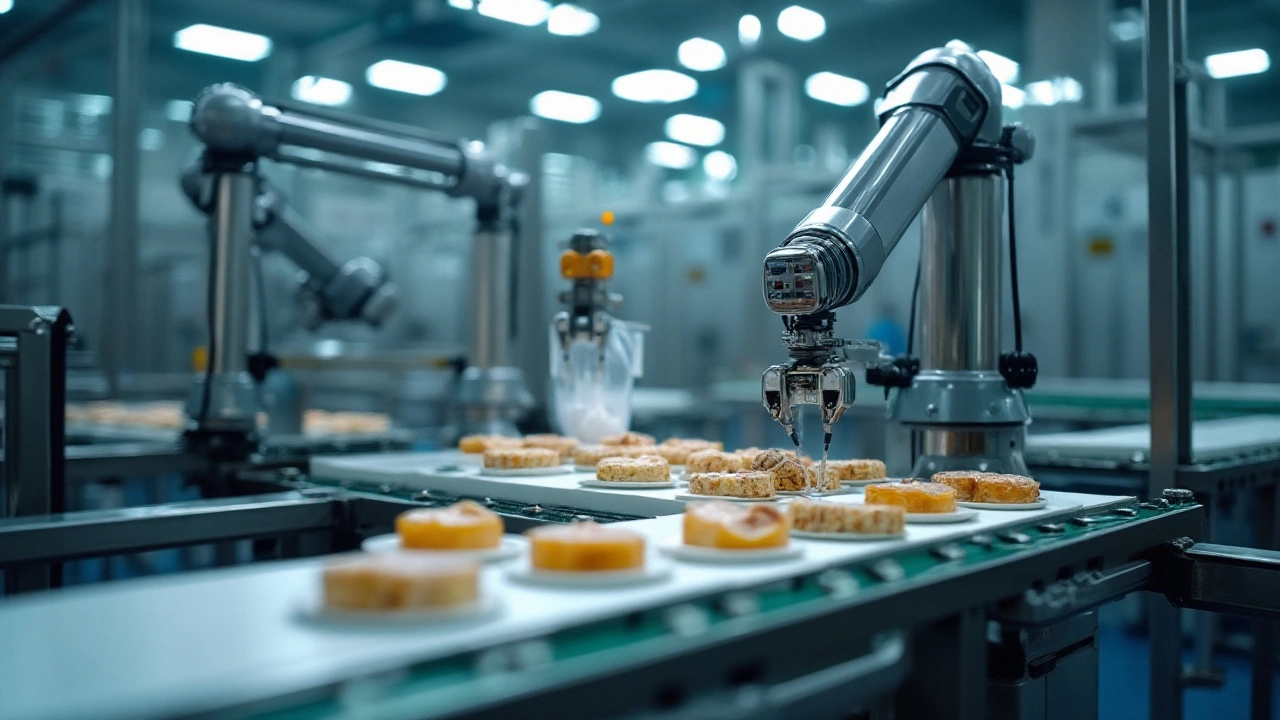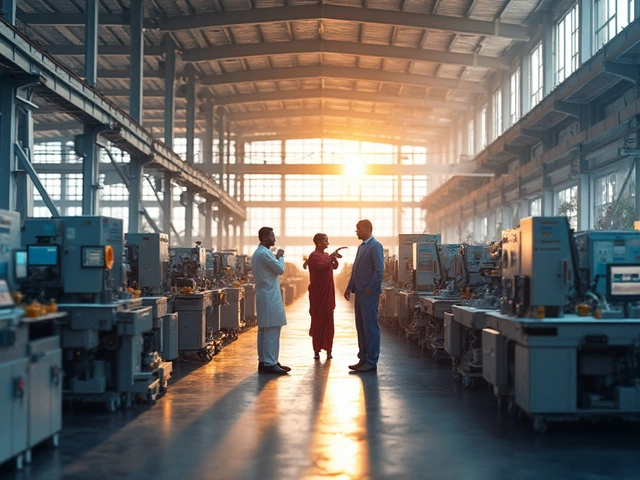
The world of food processing is a vibrant and essential component of the food industry. It involves a wide range of units and equipment that transform raw ingredients into consumable products, maintaining safety and enhancing flavors. The classification of these units is not merely academic; it has real-world implications for how food is prepared and distributed.
Different types of processing units cater to varying stages of the production process, whether it's the initial handling of raw materials or the final stages of product refinement. This classification helps industries decide the best practices to adopt, ensuring efficiency and quality. It's an exciting realm where tradition meets innovation, leading to creative solutions that fulfill both commercial demands and consumer expectations.
- Understanding Food Processing
- Primary Processing Units
- Secondary Processing Units
- Specialized Processing Equipment
- Technological and Innovative Trends
Understanding Food Processing
The process of transforming raw agricultural products into edible food involves a complex web of activities collectively known as food processing. It forms the backbone of the food industry, which plays a pivotal role in ensuring that the world’s growing population has access to safe, nutritious, and tasty food. At its core, food processing is all about converting raw materials into finished products, using various methods to enhance flavor, texture, and shelf life. This field is divided mainly into primary and secondary processing, each with its specific functions and impact on the food supply chain.
Primary processing is the initial stage, involving the preparation of raw materials that are typically harvested directly from farms. This can include activities such as cleaning, milling, drying, or fermenting. For instance, primary processing is responsible for turning wheat into flour or transforming cocoa beans into cocoa powder. It often takes place close to the source of raw materials, reducing transportation costs and minimizing spoilage risks, which is essential for maintaining overall quality and freshness. A fascinating fact relates to milling practices; records show that modern industrial mills are capable of processing vast amounts of grain efficiently due to advances in technology.
Secondary processing delves deeper into transforming these primary products into consumer-ready food items, such as bread from flour or chocolate from cocoa. This stage may involve more sophisticated techniques like fermentation, pasteurization, or chemical transformations, ensuring that products meet health standards and consumer preferences. Much of this work takes place in specialized facilities with specific equipment designed for precise operations. Insider studies reveal that automation in food processing can enhance productivity significantly, with automated controls ensuring that products remain consistent in flavor and quality.
"Food processing is not just about meeting demand; it's an industry driven by technological advancements that push the boundaries of what flavors and products we can create" – Institute of Food Technologists
Food processing units are not limited to large-scale industrial setups; they also encompass small and medium enterprises, actively contributing to local economies by engaging local resources and labor. One of the intriguing aspects of food processing is its adaptability and innovative nature, facilitating the development of novel food products that cater to evolving consumer tastes and nutritional trends. Statistics indicate that small food processing enterprises play a critical role, particularly in rural areas, providing jobs and enabling economic growth. This illustrates how food processing is as much about sustenance as it is about connecting communities and fostering economic vitality.
| Product Type | Primary Process | Secondary Process |
|---|---|---|
| Wheat | Milling | Bread-making |
| Cocoa | Fermentation | Chocolate production |
| Milk | Pasteurization | Cheese-making |
In understanding food processing, it's crucial to acknowledge its historical significance. Food preservation techniques, for example, shifted over time from ancient methods like sun-drying and salting to modern refrigeration and canning. Each advance in processing technology has responded to challenges of the day—whether it's extending shelf life or enhancing food safety—and this continues to evolve with current environmental and health awareness. This section of the food industry is not static; it’s a vibrant and integral part of global food security strategies and dietary habits. Harnessing the power of food processing units effectively is vital for catering to worldwide demands and tapping into the potential of innovation.
Primary Processing Units
In the domain of food processing, primary processing units play a pivotal role in transforming raw materials into something more usable in later stages. These units typically handle the initial phases of processing and might include cleaning, sorting, grading, and basic transformation of agricultural products. The initial steps set the stage for the quality and efficiency of the entire food processing chain. A familiar example would be the milling of grains into flour, an essential process that dates back centuries yet continues to be a cornerstone of modern food production.
Primary units focus heavily on creating products that are stable both in terms of quality and shelf life. For instance, in the meat industry, this involves steps like slaughter, cleaning, and refrigeration, while in dairy, pasteurization stands out as a critical process. Accurate handling in these stages reduces waste and ensures safety, making it a focus area for technological advancements and efficiency improvements. The goal is always to streamline the process without losing the intrinsic quality of the product.
"Efficiency in primary processing not only safeguards the initial investment in agriculture but sets the industry standard for sustainability," notes a report from the Food and Agricultural Organization.
Key Components and Equipment
The technology utilized by primary processing units varies widely depending on the food type. For grains, equipment might include dehuskers and hulling machines, whereas fruits could require peeling, slicing, and juice extraction technologies. Precision and control are paramount here; culling only the best raw materials for continued processing affects both end quality and consumer satisfaction. In today's world, equipment is increasingly automated, allowing for faster throughput and consistent quality, which is crucial for maintaining competitive edge in fluctuating markets.
Investment in advanced technology is often offset by reductions in labor costs and increases in production volumes. In regions with rich agricultural produce, such units are essential not only for local economies but also for meeting export demands, thereby aiding a country's economic resilience. Understanding these units’ contributions helps to appreciate how intricately supply chains are woven, linking farms to global markets.

Secondary Processing Units
Secondary processing units play a pivotal role in the transformation of primary processed ingredients into the myriad of products that crowd our pantry shelves or dazzle us in grocery aisles. These units are where the magic of turning simple, often unassuming ingredients into high-quality end products occurs. In essence, they deal with the alteration and blending of food in a myriad of ways to enhance flavor, appearance, and nutritional value. Think of these units as the culinary artists of the industrial food world, where each piece of equipment is a crafted tool that brings culinary visions to life.
Common secondary processing operations include baking, fermentation, pickling, emulsification, and many more. For instance, the journey from fresh dough to a perfectly baked loaf involves a series of precise actions orchestrated by a combination of mixers, proofers, and ovens, each catering to specific bread characteristics. Another fascinating example is in the dairy sector where raw milk undergoes pasteurization, homogenization, and curdling to create a wide range of products from butter, cheese to yogurt, each with its distinct taste and texture. These processes are not only about transformation but often about preservation, ensuring the food retains its quality over time.
The U.S. Department of Agriculture reports, 'Advancements in food processing technologies have significantly reduced food spoilage and loss, aiding in better food storage and distribution.' – USDA
The innovations in secondary processing are endless. There is an increasing trend towards refining methods that reduce nutrient loss and enhance flavor without artificial additives. At the heart of many secondary processing units are specialized machines designed with the unique capabilities to perform specific tasks. These machines may include chillers for maintaining precise temperatures, grinders for adjusting texture, and tumblers for marinating meats. Each unit is finely tuned to achieve consistency and quality that consumers expect and rely on.
In terms of numbers, secondary processing units often operate at astounding scales. It's common to see assembly lines where hundreds of thousands of products are made daily, especially in industries that boast global distribution networks. Automation has become a key feature in these setups, reducing human error and increasing efficiency. However, many smaller-scale operations thrive by offering artisanal products that demand a particular human touch, say a handcrafted chutney or a boutique cheese, demonstrating that secondary processing is diverse in approach and target market.
These hubs of transformation are not only technical marvels but also centers of sustainability efforts. Modern processors are increasingly adopting eco-friendly practices, such as reducing waste through by-product utilization and improving energy efficiencies. Sustainable practices are now a crucial part of the conversation, with businesses striving to lower their environmental footprint.
In summary, secondary processing units are essential not only in bringing about the final consumable form of our foods but also in actively shaping the future of the food processing industry through responsible, innovative, and quality-driven approaches.
Specialized Processing Equipment
In the ever-evolving landscape of the food processing units industry, specialized processing equipment plays a pivotal role. This equipment is designed to handle specific tasks with precision, ensuring that the quality and efficiency of food production meet the high standards of both manufacturers and consumers. From peeling and chopping machines to sophisticated homogenizers and emulsifiers, each piece of equipment is instrumental in converting raw ingredients into market-ready products.
One of the fascinating aspects of specialized equipment is its ability to adapt to different scales of production. For instance, industrial peeling machines can handle several tons of vegetables per hour, essential for mass production lines, while smaller, artisanal units offer precise control for gourmet products. The technological advancements in this equipment have amplified productivity, reduced waste, and enhanced the safety and hygiene standards of food processing. According to the Food Engineering Department at the University of Guelph, “Innovation in processing equipment has allowed for the exponential growth and diversification of the food industry, leading to new product categories and healthier, more sustainable options.”
Another critical factor in specialized processing equipment is automation and AI integration. Modern units equipped with sensors and AI capabilities can monitor and adjust processes in real-time, minimizing human error and optimizing resource use. This technological integration not only improves efficiency but also provides detailed data that can be used to refine production processes further. The use of technology extends to monitoring temperature, moisture, and acidity levels, which are crucial elements in maintaining the quality of food products. For example, automated systems in cheese production can fine-tune humidity and temperature, ensuring each batch meets exacting standards.
Trends in Equipment Design
The design and engineering of specialized processing equipment continuously evolve to meet the demands of health-conscious consumers and sustainability advocates. Modern equipment is often built with energy efficiency in mind, allowing for significant reductions in carbon footprints. Machines that require less water for cleaning or adopt closed-loop systems for energy use are increasingly popular. These innovations not only support environmental goals but also reduce operational costs for factories, making them a smart investment for businesses of all sizes.A growing trend involves the modular design of equipment. This allows food manufacturers to customize their processing lines, easily swapping out components to adjust for different product requirements. For example, a modular system in a bakery can allow for rapid changes from baking bread to pastries with minimal downtime. This flexibility is invaluable in today's rapidly changing market where consumer preferences can shift quickly.
Below is a table showcasing some of the cutting-edge technologies being integrated into food processing equipment:
| Technology | Application | Benefits |
|---|---|---|
| AI and Machine Learning | Real-time adjustments | Enhanced precision, reduced waste |
| IoT Connectivity | Data tracking and trends analysis | Improved process insights, predictive maintenance |
| Energy Efficient Motors | Reduced energy consumption | Cost savings, lowered environmental impact |
Specialized processing equipment isn't just about innovation; it's about building a more resilient and flexible food production ecosystem. Whether addressing the needs of large-scale industries or supporting the artisanal craftsperson, these machines offer the tools needed to navigate the complexities of today’s food landscape.

Technological and Innovative Trends
In recent years, the food processing industry has witnessed transformative changes, propelled by cutting-edge technological advancements. These innovations have not only increased efficiency but also enhanced food safety and expanded the capabilities of various processing units. One notable trend is the integration of robotics and automation, which is streamlining operations and reducing human error. By automating repetitive tasks, companies are able to ensure consistency and maintain hygiene standards, all while significantly boosting productivity. Machines equipped with artificial intelligence have been trained to handle delicate processes, such as sorting and packaging, with precision previously unimaginable. This technological leap is giving small and large food processing units the capability to meet rising demands without compromising on quality.
Machine learning algorithms are being employed to predict maintenance needs, thereby reducing downtime and unexpected breakdowns in processing equipment. Predictive analytics is now playing a crucial role, allowing operators to schedule preemptive repairs and optimize work schedules. Additionally, food processors are harnessing the power of the Internet of Things (IoT). By integrating smart sensors into machinery, operators can monitor real-time data on temperature, pressure, and humidity. This real-time monitoring not only ensures optimal operating conditions but also enhances traceability and transparency across the production line. The collected data can be used to generate insights regarding product quality and operational efficiency, enabling decision-makers to implement improvements rapidly.
The global food processing equipment market size was valued at over USD 55 billion in 2022 and is anticipated to expand at a compound annual growth rate (CAGR) of 6.5% from 2023 to 2030. This growth is fueled by technological innovations focusing on energy efficiency and food quality.
Another innovative trend making waves is the adoption of sustainable technologies. Modern processors are highly focused on minimizing their environmental footprint. Energy-efficient machinery, waste-management systems, and water-conservation technologies are increasingly being utilized in food processing facilities. These green technologies lower costs and help companies achieve sustainability goals, which is invaluable in today's eco-conscious market. Furthermore, alternative processing methods, such as high-pressure processing and ultrasonic processing, are gaining traction. These methods often require less energy and preserve nutrient content, quality, and natural flavors in foods, offering an attractive option for food processing units aiming to deliver health-focused products.
In line with these technological strides, innovations like 3D food printing are carving a niche, especially in custom and high-volume production lines. This form of food processing allows for the creation of intricate designs and unique textures, appealing to gourmet chefs and large-scale manufacturers alike. The flexibility offered by such technology breaks traditional barriers to creativity and has already started changing the landscape of food offerings available to consumers. Finally, blockchain technology is emerging as a formidable tool for enhancing food safety and supply chain transparency. By providing a decentralized and immutable ledger of transactions, blockchain helps ensure traceability and accountability from farm to table. As the digital map of food journeys becomes more accessible, consumers can make informed choices about the products they purchase, significantly boosting consumer trust.
The future of the food industry undeniably lies in these technological and innovative trends. They are redefining the possibilities within food processing units, paving the way for an era where sustainability, efficiency, and high quality walk hand in hand. Stakeholders who are keen on adopting these innovations stand to gain a competitive edge while making profound contributions to sustainable and efficient food production.




